2. 安徽省细菌耐药监控中心,安徽 合肥 230022;
3. 安徽医科大学细菌耐药研究所,安徽 合肥 230022
2. Anhui Center for Survei-llance of Bacterial Antimicrobial Resistance, Hefei 230022, China;
3. Institute of Bacterial Antimicrobial Resistance, Anhui Medical University, Hefei 230022, China
细菌性肝脓肿(pyogenic liver abscess, PLA)是一种由致病菌侵入肝脏引起的局部肝实质液化及坏死性疾病,如未能尽早识别与治疗,严重者可危及患者生命安全。近年来,PLA发生率逐年增加[1-2]。其中中国台湾PLA发生率达(15~16)例/10万。糖尿病(diabetes mellitus, DM)是PLA患者的易感因素之一,两者存在高共存率[3],DM合并PLA患者临床症状不典型,后期症状加重,迁延不愈,加大了临床诊疗难度。本研究旨在通过回顾性分析DM患者合并PLA的临床特点,以期为其临床诊疗提供指导。
1 对象与方法 1.1 研究对象选取安徽医科大学第一附属医院2002年7月—2022年2月住院且资料完整的PLA患者,本研究已获得该院医学伦理委员会批准(PJ 2023-01-62)。
1.2 纳入与排除标准纳入标准:①参照2020年《中国2型糖尿病防治指南》[4]诊断为DM的患者;②参照2022年中华医学会急诊医学分会发布的《细菌性肝脓肿诊治急诊专家共识》[5]诊断为PLA的患者;③临床病例资料完整。排除标准:①妊娠期及分娩期妇女;②结核性、阿米巴性肝脓肿及肝包虫病患者;③合并血液系统疾病患者。
1.3 研究方法根据PLA患者是否合并DM,分为DM+PLA组与非糖尿病(NDM)+PLA组。回顾性分析两组患者的一般资料、首发临床表现及体征、并发症、生化及病原学检查结果,以及影像学表现、临床疗效和影响因素。
1.4 临床疗效判断标准① 痊愈:临床症状及体征完全消失,脓肿完全吸收;②好转:临床症状及体征较前好转,影像学检查提示脓肿处于吸收期表现;③无效:症状体征无好转,脓肿大小无变化甚至扩大。痊愈、好转为治疗有效。病历资料收集时间为患者出院后。
1.5 统计学分析应用SPSS 21.0统计学软件对数据进行分析。正态分布的计量资料以均数±标准差(x±s)表示,两组之间的比较采用独立样本t检验;非正态分布计量资料以中位数(四分位数间距)[M(P25,P75)]表示,组间比较采用Mann-Whitney检验。计数资料以率(%)表示,两组之间比较采用卡方检验。预后的危险因素采用logistic回归分析,先进行单因素分析,对单因素分析结果显示的部分变量再进行多因素分析。P≤0.05为差异有统计学意义。
2 结果 2.1 一般资料2002年7月—2022年2月该院共收治符合纳入与排除标准的PLA患者695例,其中男性428例,女性267例。男性中DM、NDM分别为130、298例,女性中分别为61、206例。DM+PLA组191例(27.5%),NDM+PLA组504例(72.5%)。PLA患者以男性为主,且DM+PLA组中男性患者占比多于NDM+PLA组;DM+PLA组患者合并高血压的占比高于NDM+PLA组;而胆道疾病及恶性肿瘤的占比低于NDM+PLA组;差异均有统计学意义(均P < 0.05)。见表 1。
| 表 1 两组PLA患者临床资料比较 Table 1 Comparison of clinical data between two groups of PLA patients |
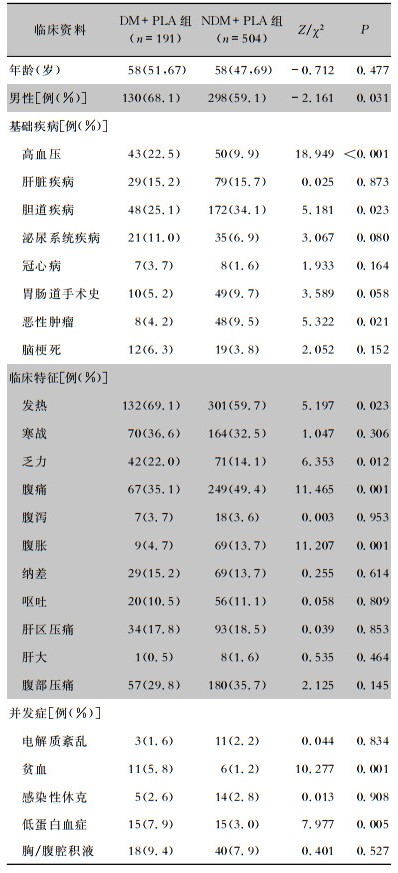
|
PLA患者可出现发热、寒战、乏力、腹痛和腹胀等临床症状。其中,DM+PLA组患者出现发热、乏力的占比均高于NDM+PLA组(均P < 0.05),而出现腹痛、腹胀的占比均低于NDM+PLA组(均P < 0.05);出现寒战、腹泻、纳差、呕吐、肝区压痛、肝大和腹部压痛等临床症状的占比两组比较,差异均无统计学意义(均P>0.05)。见表 1。
2.3 并发症发生情况DM+PLA组患者并发贫血、低蛋白血症的占比均高于NDM+PLA组(均P < 0.05),其余并发症的发生比例,两组比较差异均无统计学意义(均P>0.05)。见表 1。
2.4 生化检测结果生化检测结果显示,中性粒细胞计数、中性粒细胞百分比、碱性磷酸酶及血糖DM+PLA组患者均高于NDM+PLA组患者(均P < 0.05);总蛋白、清蛋白含量、清蛋白/球蛋白比值、总胆红素、直接胆红素、间接胆红素DM+PLA组患者均低于NDM+PLA组患者(均P < 0.05)。见表 2。
| 表 2 两组PLA患者生化检查结果 Table 2 Biochemical test results of two groups of patients |
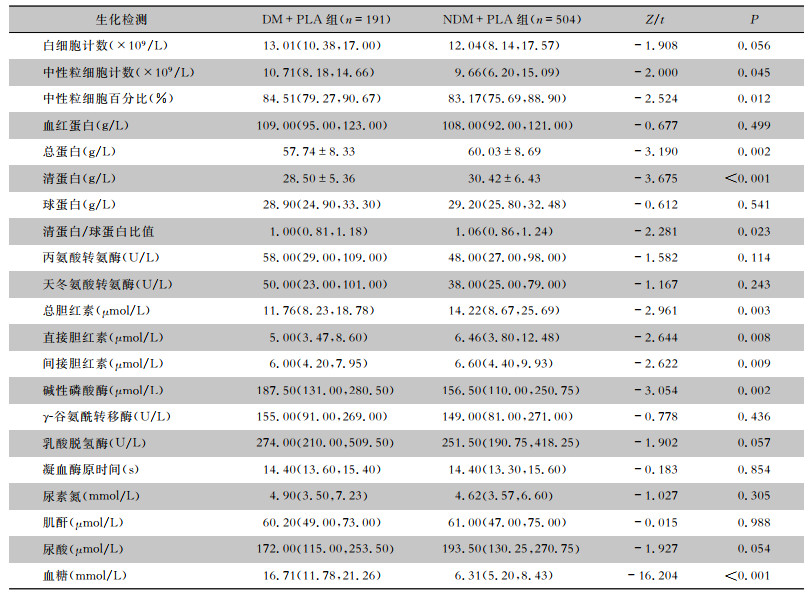
|
病原学检测结果显示,DM+PLA组患者病原学检查阳性89例,其中55例检出肺炎克雷伯菌,14例检出大肠埃希菌,20例检出其他病原菌;NDM+PLA组患者病原学检查阳性159例,其中61例检出肺炎克雷伯菌,34例检出大肠埃希菌,64例检出其他病原菌。DM+PLA组患者检出肺炎克雷伯菌的占比较NDM+PLA组更高(61.8% VS 38.4%,P < 0.001)。见表 3。
| 表 3 两组PLA患者病原学及影像学检查结果[例(%)] Table 3 Pathogenic and imaging examination results of two groups of patients (No. of cases [%]) |
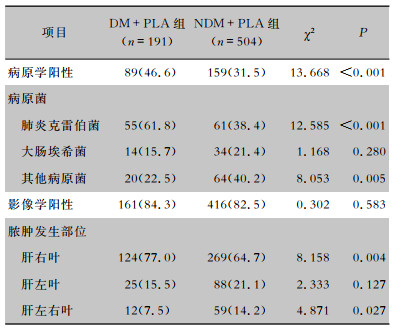
|
影像学检查结果显示,DM+PLA组与NDM+PLA组患者检查阳性分别为161、416例。其中DM+PLA组患者检出肝右叶脓肿124例,肝左叶脓肿25例,肝左右叶脓肿12例;NDM+PLA组患者检出肝右叶脓肿269例,肝左叶脓肿88例,肝左右叶脓肿59例。与NDM+PLA组患者比较,DM+PLA组患者肝右叶脓肿比率更高(77.0% VS 64.7%),肝左右叶脓肿比率更低(7.5% VS 14.2%),差异均有统计学意义(均P < 0.05)。见表 3。
2.7 治疗情况PLA患者使用抗菌药物治疗,以抗厌氧菌药物联合头孢类或者喹诺酮类、碳青霉类抗生素为主,抗菌药物使用中抗厌氧菌药物、头孢类抗生素、喹诺酮类和碳青霉烯类使用率分别为58.7%、75.2%、41.0%、42.2%。DM+PLA组和NDM+PLA组患者进行侵入性治疗例数分别为93、203。见表 4。
| 表 4 两组PLA患者治疗情况[例(%)] Table 4 Treatment of two groups of patients (No. of cases [%]) |
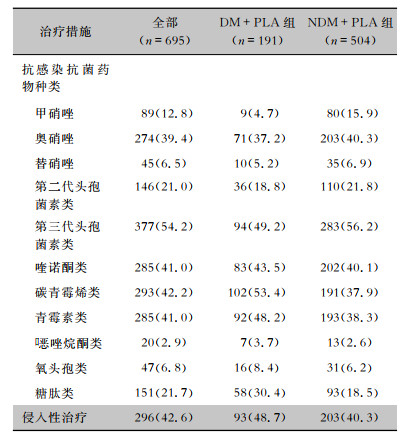
|
DM+PLA组患者治愈21例(11.0%),好转134例(70.2%),未愈35例(18.3%),死亡1例(0.5%);NDM+PLA组患者治愈58例(11.5%),好转333例(66.1%),未愈110例(21.8%),死亡3例(0.6%)。DM+PLA组患者住院日数[18(12, 27)d]较NDM+PLA组患者长[15(9, 22)d;Z=-3.941,P<0.001]。
单因素logistic回归分析结果显示,影响DM+PLA组患者预后因素包括恶性肿瘤、脑梗死及侵入性治疗;影响NDM+PLA组患者临床疗效的因素包括血糖、肝脏基础疾病、恶性肿瘤及侵入性治疗。对单因素结果进行多因素logistic回归分析,两组患者临床疗效可能的影响因素赋值见表 5,结果显示恶性肿瘤为影响DM+PLA组患者临床疗效的危险因素,而侵入性治疗为其保护因素;而NDM+PLA组患者恶性肿瘤和血糖为影响其临床疗效的危险因素,而侵入性治疗则为保护因素。见表 6。
| 表 5 PLA患者临床疗效的影响因素与赋值表 Table 5 The infuencing factors and assignment table of clinical efficacy in PLA patients |
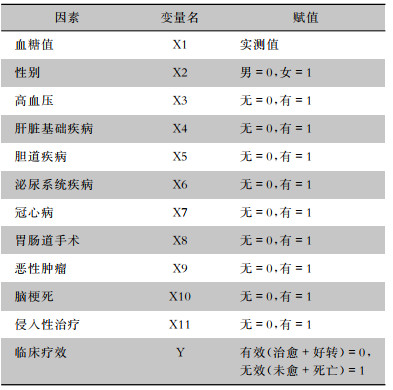
|
| 表 6 两组PLA患者多因素logistic回归分析结果 Table 6 Multivariate logistic regression analysis results of two groups of PLA patients |
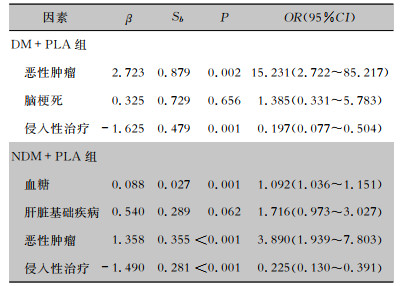
|
PLA是化脓性细菌入侵肝脏引起的疾病,患者可出现发热、寒战和肝区疼痛等临床症状。而DM患者合并PLA时临床症状隐匿,易被忽视和延误治疗时机,从而加重病情。因此,及早发现、诊断及治疗尤为重要。
本研究结果显示,PLA患者以中老年男性居多,其中DM+PLA组中男性患者占比更高,与DM好发于男性群体密不可分。DM+PLA组患者中高血压占比较高,与DM患者代谢异常,高血糖及过量游离脂肪酸可通过一系列作用影响血管壁,包括内皮细胞功能障碍等,促进了高血压及其他心血管疾病的发生有关[6-7]。
PLA患者可出现发热、寒战、腹痛等临床症状,其中DM+PLA组患者发热及乏力占比较NDM+PLA组更高,说明DM+PLA组患者存在更重的炎症反应;而腹胀、腹痛占比较低,可能与DM损伤神经功能,导致痛阈提高和敏感性下降相关[8]。人体内长期高血糖水平可诱导红细胞膜蛋白发生糖基化,使其变形能力下降,寿命缩短,破坏增多,并可对肾脏功能造成损伤,增加蛋白流失,促进患者贫血与低蛋白血症的发生[9-10]。本研究存在相同结果,即DM+PLA组患者合并贫血与低蛋白血症的情况较NDM+PLA组更多。
生化结果分析显示,PLA患者白细胞计数均升高,其中DM+PLA组患者白细胞计数高于NDM+PLA组患者(P < 0.05),与相关献报道[11]的结果一致。DM+PLA组患者肝损伤指标较NDM+PLA组变化更明显。与长期高血糖水平诱导机体慢性炎症的发生,增加对肝脏的损伤相关[12];同时DM患者需要长期口服降糖药维持血糖水平稳定,加重了肝脏代谢负担,增加对肝功能的损伤。
病原学结果显示,PLA致病菌以肺炎克雷伯菌为主,且DM+PLA组患者肺炎克雷伯菌检出占比较NDM+PLA组患者更高,与肺炎克雷伯菌逐渐成为DM+PLA的主要致病菌文献报道一致[13]。在影像学结果中,PLA易发生于肝右叶,少数患者发生于肝左叶或者肝左右叶,且以单个脓肿发生居多。主要原因考虑与肝右叶体积大,门静脉血流丰富,增加了致病菌与肝右叶接触的机会。
在治疗方面,PLA患者以加强营养,配合抗厌氧菌药物联合头孢类或者喹诺酮类、碳青霉类抗生素为临床治疗的主要手段。DM+PLA组患者住院日数长于NDM+PLA组,可能与DM患者临床症状重,PLA抗菌药物治疗不易控制,以及DM患者需要较长时间检测血糖变化有关。
在PLA患者临床疗效与DM回归分析中,并未发现两者之间存在明显的关系,因此按PLA是否合并DM进行分组回归分析,发现影响DM+PLA组临床疗效的危险因素为恶性肿瘤,而影响NDM+PLA组临床疗效的危险因素为恶性肿瘤及血糖,同时侵入性治疗为影响PLA患者临床疗效的保护性因素。在NDM+PLA组患者中,血糖对临床疗效存在危害作用,随着血糖的升高,患者发生预后不良的概率升高。但DM+PLA组患者血糖与临床疗效无明显关联,考虑可能与样本量,预后划分的标准有关。此外,本研究中单次血糖不能完全反映血糖控制情况,提示需进一步探索血糖控制情况与疾病临床疗效的联系。总体来说,在治疗过程中,应着重考虑相关临床症状及生化指标,当使用药物抗感染配合加强营养治疗未见效果时,应及时辅以侵入性治疗[14]。同时应兼顾血糖控制,加强营养治疗,改善患者精神状态,这些对PLA治愈有积极意义。
综上所述,DM+PLA患者发病隐匿,临床症状常不典型,较NDM+PLA患者有更明显的炎症反应和肝损伤表现,以及较长的治疗时间。因此,在临床中对DM伴有发热的患者应积极及时进行生化、影像学及病原学检查,避免延误诊断,加重病情。抗菌药物配合加强营养治疗相当重要,必要时应及时辅以侵入性治疗手段。本项研究主要集中于一所医院,缺乏不同地区的资料,有一定的局限性,有待进一步调研进行全面的回顾分析。
利益冲突:所有作者均声明不存在利益冲突。
| [1] |
Yang QW, Jia XM, Zhou ML, et al. Emergence of ST11-K47 and ST11-K64 hypervirulent carbapenem-resistant Klebsiella pneumoniae in bacterial liver abscesses from China: a molecular, biological, and epidemiological study[J]. Emerg Microbes Infect, 2020, 9(1): 320-331. DOI:10.1080/22221751.2020.1721334 |
| [2] |
Alkomos MF, Estifan E, Melki G, et al. Epidemiological, clinical, microbiological, and risk factors of pyogenic liver abscess: an 18-years retrospective single-center analysis[J]. J Community Hosp Intern Med Perspect, 2021, 11(1): 42-45. DOI:10.1080/20009666.2020.1831745 |
| [3] |
Wang JL, Hsu CR, Wu CY, et al. Diabetes and obesity and risk of pyogenic liver abscess[J]. Sci Rep, 2023, 13(1): 7922. DOI:10.1038/s41598-023-34889-z |
| [4] |
中华医学会糖尿病学分会. 中国2型糖尿病防治指南(2020年版)(上)[J]. 中国实用内科杂志, 2021, 41(8): 668-695. Chinese Diabetes Society. Guideline for the prevention and treatment of type 2 diabetes mellitus in China(2020 edition)(Part 1)[J]. Chinese Journal of Practical Internal Medicine, 2021, 41(8): 668-695. |
| [5] |
中华医学会急诊医学分会. 细菌性肝脓肿诊治急诊专家共识[J]. 中华急诊医学杂志, 2022, 31(3): 273-280. Emergency Medicine Branch of Chinese Medical Association. Expert consensus on diagnosis and treatment of bacterial liver abscess in emergency department[J]. Chinese Journal of Emergency Medicine, 2022, 31(3): 273-280. DOI:10.3760/cma.j.issn.1671-0282.2022.03.003 |
| [6] |
Koska J, Saremi A, Howell S, et al. Advanced glycation end products, oxidation products, and incident cardiovascular events in patients with type 2 diabetes[J]. Diabetes Care, 2018, 41(3): 570-576. DOI:10.2337/dc17-1740 |
| [7] |
Sun J, Huang XZ, Niu C, et al. aFGF alleviates diabetic endothelial dysfunction by decreasing oxidative stress via Wnt/β-catenin-mediated upregulation of HXK2[J]. Redox Biol, 2021, 39: 101811. DOI:10.1016/j.redox.2020.101811 |
| [8] |
Karlsson P, Gylfadottir SS, Kristensen AG, et al. Axonal swellings are related to type 2 diabetes, but not to distal diabetic sensorimotor polyneuropathy[J]. Diabetologia, 2021, 64(4): 923-931. DOI:10.1007/s00125-020-05352-9 |
| [9] |
Sohn M, Lee JE, Ahn M, et al. Correlation of dynamic membrane fluctuations in red blood cells with diabetes mellitus and cardiovascular risks[J]. Sci Rep, 2021, 11(1): 7007. DOI:10.1038/s41598-021-86528-0 |
| [10] |
Srivastava SP, Zhou H, Setia O, et al. Loss of endothelial glucocorticoid receptor accelerates diabetic nephropathy[J]. Nat Commun, 2021, 12(1): 2368. DOI:10.1038/s41467-021-22617-y |
| [11] |
Wang WJ, Tao Z, Wu HL. Etiology and clinical manifestations of bacterial liver abscess: a study of 102 cases[J]. Medicine (Baltimore), 2018, 97(38): e12326. DOI:10.1097/MD.0000000000012326 |
| [12] |
Sun Y, Zhou YC, Shi Y, et al. Expression of miRNA-29 in pancreatic β cells promotes inflammation and diabetes via TRAF3[J]. Cell Rep, 2021, 34(1): 108576. DOI:10.1016/j.celrep.2020.108576 |
| [13] |
Wang F, Yu JW, Chen WJ, et al. Clinical characteristics of diabetes complicated by bacterial liver abscess and nondiabetes-associated liver abscess[J]. Dis Markers, 2022, 2022: 7512736. |
| [14] |
Pais-Costa SR, Araujo SLM, Figueiredo VN. Hepatectomy for pyogenic liver abscess treatment: exception approach?[J]. Arq Bras Cir Dig, 2018, 31(3): e1394. |

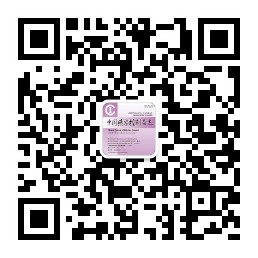


 唑烷酮类
唑烷酮类